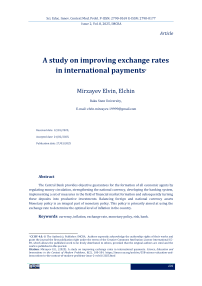A study on improving exchange rates in international payments
Автор: Mirzayev E.E.
Журнал: Science, Education and Innovations in the Context of Modern Problems @imcra
Статья в выпуске: 2 vol.8, 2025 года.
Бесплатный доступ
The Central Bank provides objective guarantees for the formation of all economic agents by regulating money circulation, strengthening the national currency, developing the banking system, implementing a set of measures in the field of financial market formation and subsequently turning these deposits into productive investments. Balancing foreign and national currency assets Monetary policy is an integral part of monetary policy. This policy is primarily aimed at using the exchange rate to determine the optimal level of inflation in the country.
Currency, inflation, exchange rate, monetary policy, risk, bank
Короткий адрес: https://sciup.org/16010399
IDR: 16010399 | DOI: 10.56334/sei/8.2.8
Текст научной статьи A study on improving exchange rates in international payments
-
1 CC BY 4.0. © The Author(s). Publisher: IMCRA. Authors expressly acknowledge the authorship rights of their works and grant the journal the first publication right under the terms of the Creative Commons Attribution License International CC-BY, which allows the published work to be freely distributed to others, provided that the original authors are cited and the work is published in this journal.
Citation: Mirzayev E.E., (2025). A study on improving exchange rates in international payments. Science, Education and Innovations in the Context of Modern Problems, 8(2), 100-104.

Issue 2, Vol. 8, 2025, IMCRA
Introuction
One of the main goals of monetary policy is to maintain the stability of each country's national currency. The exchange rate is the price of one country's currency expressed in the currency of another country. It has an important role in the system of international economic relations. Thus, changes in the exchange rate have a significant impact on the prices of exported and imported goods, the competitiveness of national production in the world market.
International settlements use two different types of manat exchange rates, taking into account the scope and nature of foreign exchange transactions: special exchange rate for foreign trade operations and special exchange rate of manat against convertible currency. It interferes in the foreign exchange market by conducting operations and can limit the deviation of the selling rate from the buying rate. A number of factors play an important role in determining the exchange rate:
-
• Changes in consumer tastes
-
• Relative changes in income
-
• Relative changes in price
-
• Relative real interest rate
-
• Speculation and so on.
Discussion
It should be noted that the exchange rate and the state of international payments are closely linked to the state of the national money market. The higher the volume of money in circulation, the lower its value in the national and international markets. Therefore, the most important condition for foreign trade, loans, investments, interstate payments is the exchange of one currency for another (Yoon, 2009). This exchange is carried out through foreign exchange markets. In terms of function and direction of activity, foreign exchange markets provide the following:
Timely implementation of international settlements
Currency risk insurance
Determining the composition of foreign exchange reserves of the state, banks and enterprises
-
- Regulation of exchange rates
In general, if the exchange rate increases in international settlements, the demand for currency usually increases (Turhan, et.al. 2013). When the exchange rate rises, the supply of foreign currency usually increases. The high exchange rate allows citizens to get more national currency. The price of the currency is formed as a result of the balance of supply and demand. When the exchange rate decreases, the supply of currency decreases or, conversely, the demand for currency increases (Ekaterini Panopoulou & Theologos Pantelidis, 2015). In international settlements, the exchange rate is formed in the foreign exchange market.
In modern times, the main focus will be on ensuring the balanced development of the banking sector (David A, 2016). Consolidation measures and structural reforms will be continued in the banking sector, focusing on stimulating competition and improving the quality of financial and banking services, as well as improving the infrastructure and expanding its coverage. The capitalization of the banking system will be continued, the expansion of the banking network in the regions will be in the focus of attention, and the mechanism of mortgage lending will be improved.
Issue 2, Vol. 8, 2025, IMCRA
As in all countries, the monetary policy plays an important role in the development of the economy in our country. Monetary policy plays a key role in international settlements and is an important part of economic policy. Monetary policy is aimed at achieving multilateral economic goals, in other words, ensuring strong economic development, curbing unemployment and inflation, and reflects the relationship between countries.
To achieve the goal of monetary policy, the Central Bank uses monetary policy instruments. The central bank seeks to achieve its ultimate goal by influencing the money supply, exchange rates, and interest rates through the instruments of monetary policy at its disposal. To make adequate decisions on monetary policy, the Central Bank constantly analyzes and forecasts the macroeconomic situation in the country.
Conclusion
The macroeconomic situation is regularly discussed in the Monetary Policy Committee and the Board, which are collegiate management bodies of the Central Bank, and decisions on monetary policy are made based on these discussions. Decisions are communicated to the public through the means of communication of the Central Bank, including press releases.
The Central Bank prepares a statement on the main directions of monetary policy for the coming year (as well as the medium term) and publishes it. The document outlines the macroeconomic policy framework for the current year, the results of monetary policy, the goals and objectives of monetary policy for the coming year, ways to implement them, as well as mediumterm policy directions.
The Central Bank prepares and publishes a quarterly Monetary Policy Review to inform the general public about the macroeconomic situation and monetary policy pursued throughout the year.


